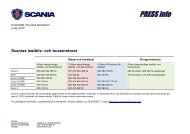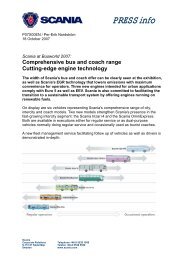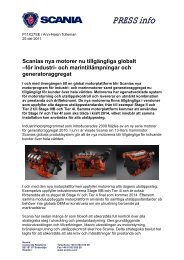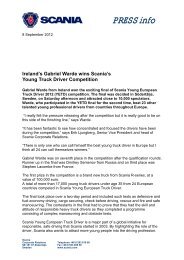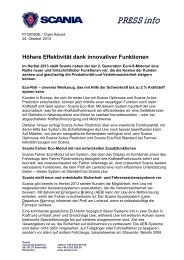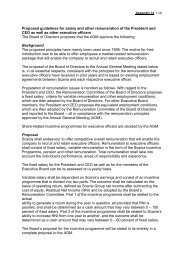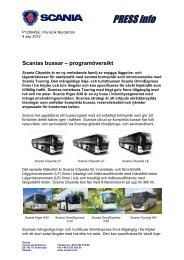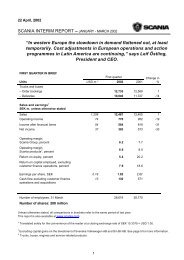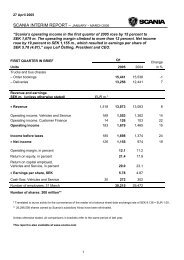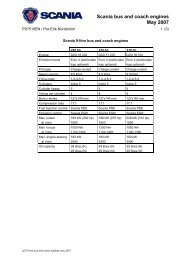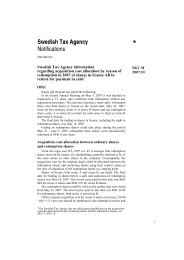Scania annual report 2004
Scania annual report 2004
Scania annual report 2004
You also want an ePaper? Increase the reach of your titles
YUMPU automatically turns print PDFs into web optimized ePapers that Google loves.
and equipment. However, the recommendation<br />
allows two alternative methods for appraising<br />
these assets. Either the revaluation model, which<br />
means that assets can be carried at regularly<br />
revalued amounts, or the cost model, which states<br />
that the assets shall be carried at acquisition<br />
value. <strong>Scania</strong> has chosen to use the cost model<br />
in appraising its fixed assets.<br />
IAS 17 Leases<br />
<strong>Scania</strong> applied IAS 17 during earlier financial<br />
years and <strong>report</strong>s, and discloses all lease obligations<br />
in accordance with the requirements of<br />
IFRS rules.<br />
IAS 19 Employee Benefits<br />
<strong>Scania</strong> applied IAS 19 during the financial year<br />
<strong>2004</strong>, since Swedish accounting rules have coincided<br />
with IFRS via RR 29 since January <strong>2004</strong>.<br />
As a consequence of the changes in accounting<br />
rules, Note 15 has been changed compared to<br />
prior years.<br />
IAS 27 Consolidated and Separate Financial<br />
Statements<br />
According to IAS 27, minority interests shall be<br />
<strong>report</strong>ed in the consolidated balance sheet separately<br />
from the parent company’s shareholders’<br />
equity. A separate disclosure shall be provided of<br />
the minority’s share of earnings. <strong>Scania</strong> has<br />
implemented these changes in presentation in<br />
the quantified information on the IFRS transition<br />
in Note 33.<br />
IAS 32 Financial Instruments: Disclosure and<br />
Presentation<br />
IAS 32 enters into force on 1 January 2005 and<br />
requires no retroactive application. In all essential<br />
respects, the disclosure requirements in IAS 32<br />
coincide with RR 27. The requirements for <strong>report</strong>ing<br />
financial assets and liabilities on a net basis<br />
(offsetting) are changing. As a result, <strong>Scania</strong> will<br />
apply <strong>report</strong>ing on a gross basis of certain financial<br />
assets and liabilities that were previously<br />
<strong>report</strong>ed on a net basis.<br />
IAS 36 Impairment of Assets<br />
The recommendation concerns all tangible and<br />
intangible fixed assets. Goodwill as well as<br />
intangible assets with an indefinite useful life<br />
shall be tested <strong>annual</strong>ly for any need to <strong>report</strong><br />
an impairment loss. When there are indications<br />
that an impairment may exist, impairment testing<br />
shall occur. This applies to all tangible and<br />
intangible fixed assets. <strong>Scania</strong> performed impairment<br />
testing during <strong>2004</strong> for all goodwill items.<br />
No impairment loss was identified as a consequence<br />
of the impairment tests that was performed.<br />
There were no indications leading <strong>Scania</strong><br />
to carry out any impairment testing of tangible<br />
fixed assets.<br />
IAS 39 Financial Instruments:<br />
Recognition and Measurement:<br />
IAS 39 enters into force on 1 January 2005 and<br />
requires no retroactive application. IAS 39 is<br />
resulting in changes in the <strong>report</strong>ing and valuation<br />
of financial assets and liabilities, of which<br />
<strong>report</strong>ing of derivatives has the largest effect on<br />
<strong>Scania</strong>. According to the standard, all derivatives<br />
shall be recognised in the balance sheet at fair<br />
value and any changes in their fair value shall, as<br />
a main rule, be <strong>report</strong>ed in the income statement.<br />
If the derivative is part of a hedging transaction,<br />
the rules for hedge accounting may be<br />
applied, provided that the strict conditions for<br />
applying hedge accounting have been met.<br />
Hedging of cash flows<br />
Derivatives carried for the purpose of hedging<br />
expected future commercial payments in foreign<br />
currencies against currency risks will be recognised<br />
according to the rules for hedge accounting of<br />
cash flow hedges. As a result, all derivatives are<br />
carried in the balance sheet at fair value and<br />
changes in their value are recognised as part<br />
of fair value reserve in shareholders’ equity. When<br />
the hedged item is recognised in the balance<br />
sheet, a change in value related to the derivative<br />
is recognised to the income statement. If a derivative<br />
does not meet the conditions for hedge<br />
accounting, the change in fair value is <strong>report</strong>ed<br />
directly in the income statement.<br />
Currency derivatives carried in order to<br />
convert the borrowing that occurs in <strong>Scania</strong>’s<br />
subsidiaries through the corporate treasury unit<br />
into the appropriate currency are recognised at<br />
fair value and as changes in fair value in the<br />
income statement. Foreign currency borrowing<br />
is revalued at the closing day exchange rate,<br />
and exchange rate differences are recognised in<br />
earnings and thereby meet the change in value<br />
of the derivative.<br />
Hedging of fair value<br />
<strong>Scania</strong>’s external borrowing mainly occurs at<br />
the corporate level in large sums. They are then<br />
transferred to subsidiaries in the form of internal<br />
loans. To convert this borrowing to the desired<br />
interest rate refixing structure, interest rate<br />
derivatives are used. Due to the strict requirements<br />
that are imposed in order to apply hedge<br />
accounting, for administrative reasons <strong>Scania</strong><br />
has chosen not to apply hedge accounting to<br />
a number of small derivatives. As a result, the<br />
derivatives are valued at fair value and the<br />
change in value is recognised via the income<br />
statement, while borrowing is valued at accrued<br />
cost. Due to differences in the recognition of the<br />
hedging instrument and the hedged item, the<br />
accounts are subject to volatility. Financially,<br />
however, <strong>Scania</strong> is hedged and risk management<br />
complies with the Finance Policy approved by<br />
the Board of Directors.<br />
ACCOUNTING PRINCIPLES • SCANIA ANNUAL REPORT <strong>2004</strong> 56



